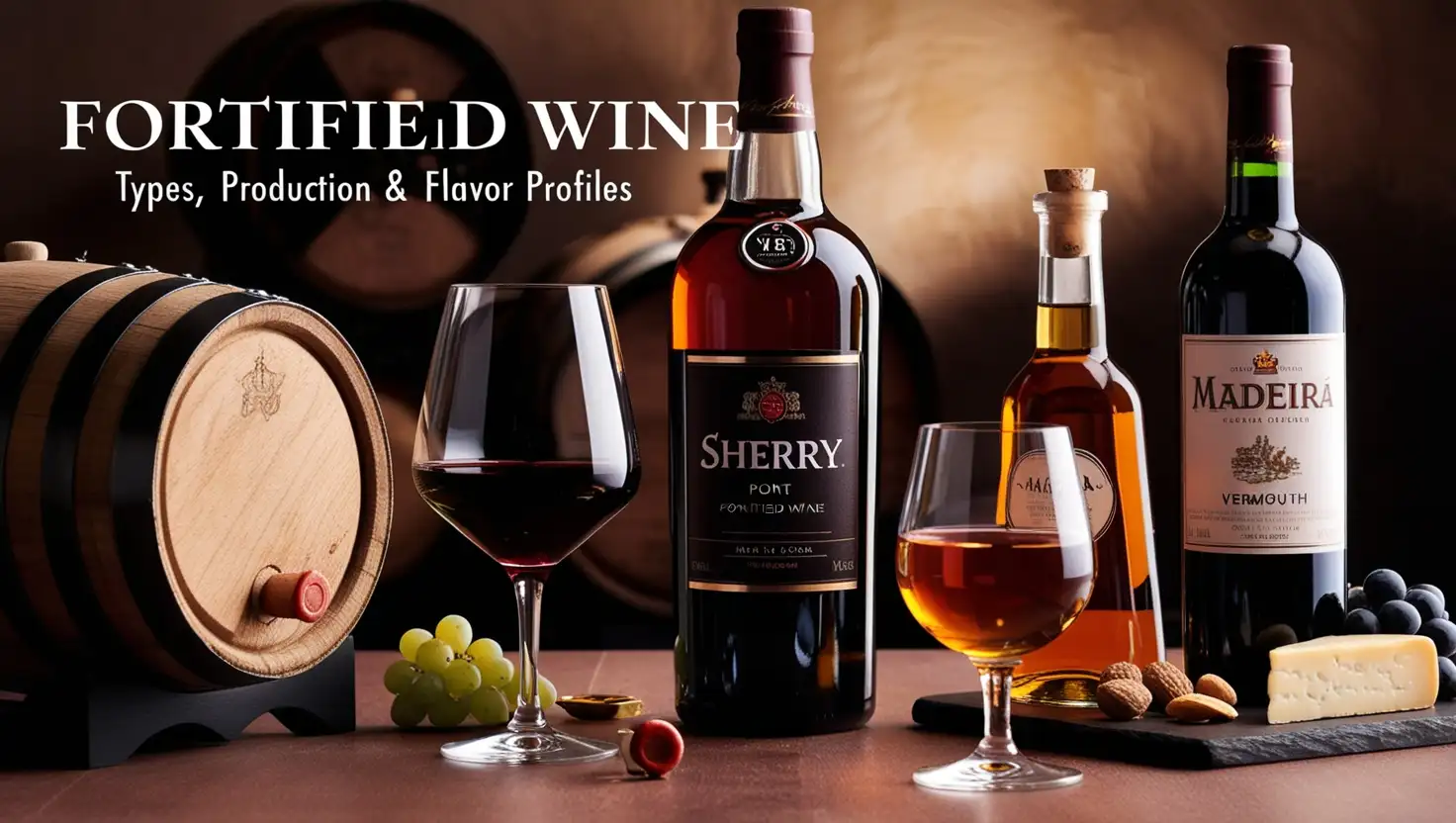Fortified wines are unique wines with enhanced alcohol content due to the addition of grape spirit. This process, originally developed to preserve wine during long sea voyages, has given rise to a variety of styles enjoyed worldwide. Depending on when the spirit is added—during or after fermentation—the wine can be sweet or dry. Fortified wines range from the rich, caramelized notes of Port and the nutty complexity of Sherry to the aromatic charm of Vermouth.
Production Process of Fortified Wine
Fortified wines undergo a unique production process that enhances their alcohol content, flavour, and ageing potential. This process involves three key stages: base wine creation, fortification, and ageing/maturation.
Each step plays a crucial role in determining the final style of the wine, whether it is sweet, dry, or somewhere in between.
1. Base Wine Creation
The production of fortified wine begins with the selection of grapes, which significantly influence the wine’s characteristics. Different fortified wines use specific grape varieties, chosen for their ability to develop complex flavours during fermentation and ageing.
- Grape Selection: The grape variety plays a key role in shaping the final taste. For example, Palomino grapes are widely used in the production of Sherry, while Touriga Nacional is one of the main grapes for Port. Madeira uses several grape varieties, such as Sercial, Verdelho, Bual, and Malmsey, each contributing to different levels of sweetness.
- Fermentation: Once harvested, the grapes undergo fermentation, a natural process in which yeast converts sugar into alcohol. The extent to which fermentation is allowed to proceed determines whether the wine will have residual sweetness or ferment completely into a dry base wine before fortification.
At this stage, the base wine is a regular still wine, which will later undergo fortification to increase its alcohol content and improve its stability.
Related: How Beer is Made: A Detailed Step-by-Step Guide
2. Fortification Process
The defining characteristic of fortified wine is the addition of grape spirit (brandy). This step increases the alcohol level and influences the wine’s flavour and sweetness. The timing of fortification is crucial in determining whether the wine will be dry or sweet.
- Fortification During Fermentation: If the grape spirit is added while the wine is still fermenting, it halts fermentation by killing the yeast before all sugars are converted into alcohol. This results in a sweeter wine because unfermented sugars remain in the final product. Examples include Port and certain styles of Madeira that retain natural sweetness.
- Fortification After Fermentation: If the wine is allowed to fully ferment before fortification, all the grape sugar is converted into alcohol, resulting in a dry wine. Fortification at this stage simply increases alcohol content without affecting sweetness. Fino Sherry and some Marsala wines are examples of dry fortified wines.
This process of adding alcohol was initially developed to help preserve wine, particularly for long sea voyages, but it also significantly influenced the final style of the wine.
3. Aging and Maturation
After fortification, the wine undergoes ageing to develop complexity and depth of flavour. Different ageing methods are used depending on the type of fortified wine being produced.
Ageing Methods for Fortified Wines
1. Solera System (Sherry)
Sherry is aged using the solera system, a method of fractional blending in which younger wines are mixed with older ones over time. This ensures consistency in quality and flavor across different vintages. The process gives Sherry its characteristic nutty, oxidative, and complex flavors.
2. Estufagem (Madeira)
Madeira undergoes a unique ageing process known as estufagem, where the wine is heated to simulate the conditions it would have experienced during historical sea voyages. This method caramelizes sugars and intensifies the wine’s flavours, giving Madeira its distinctive toffee-like, oxidized taste.
3. Barrel Aging (Port & Marsala)
Many fortified wines, including Port and Marsala, are aged in oak barrels. This aging process imparts additional flavours such as vanilla, caramel, spice, and dried fruit.
Ruby Ports are aged for shorter periods to maintain their bright fruitiness, while Tawny Ports spend years in barrels, developing nutty and caramelized characteristics.
4. Tank Aging (Vermouth & Some Sherries)
Some fortified wines, such as Vermouth, are aged in stainless steel tanks to retain their herbal and aromatic qualities rather than developing oxidative characteristics.
Explore: 16 Highly Used Wine Grape Varieties and Their Growing Regions
Popular Types of Fortified Wines
Fortified wines are enriched with grape spirits to enhance their alcohol content and flavour complexity. They are produced in various regions worldwide, each with distinct characteristics and ageing processes. Below is an in-depth look at some of the most renowned fortified wines.
1. Port Wine
Origin: Portugal
Port wine is a renowned fortified wine from Portugal’s Douro Valley, celebrated for its rich, sweet flavours and high alcohol content (19–22% ABV). It undergoes fortification by adding grape spirit, which halts fermentation and preserves natural sugars.
Ageing plays a crucial role, with some Ports maturing in barrels for enhanced complexity. Traditionally enjoyed as a dessert wine, it pairs well with cheeses, chocolates, and nuts. Port remains a symbol of Portuguese winemaking heritage, cherished worldwide.
Grape Varieties:
Several Indigenous grape varieties are used in Port production, including:
- Touriga Nacional – Provides intense flavours, structure, and ageing potential.
- Touriga Franca – Offers floral aromas and smooth texture.
- Tinta Barroca – Adds softness and body.
- Tinto Cão – Known for acidity and ageing potential.
- Tinta Roriz (also known as Tempranillo) – Contributes tannins and red fruit flavours.
Styles of Port Wine
- Ruby Port – Fruity, youthful, and deep red in color. It is usually aged for a short period in stainless steel or concrete tanks to retain freshness.
- Tawny Port – Aged in barrels, developing nutty, caramel, and dried fruit flavours with a golden-brown hue. The ageing process allows oxidation, enhancing complexity.
- Vintage Port – Produced only in exceptional harvest years and requires decades of ageing in the bottle. It is one of the most prestigious and collectable styles of Port.
- White Port – Made from white grapes, it can range from dry to sweet, often served chilled as an aperitif.
- Rosé Port – A modern style with bright berry flavours, designed for contemporary wine drinkers.
2. Sherry
Origin: Spain
Sherry is a renowned fortified wine from Spain’s Jerez region, offering a diverse range of styles from bone-dry to intensely sweet. It undergoes a unique ageing process, often using the Solera system, which blends different vintages for consistency.
Fortification occurs after fermentation, determining its dryness or sweetness. Some Sherries develop a flor yeast layer, adding distinctive nutty and briny flavours. Versatile and complex, Sherry is enjoyed as an aperitif or dessert wine, pairing well with various foods.
Grape Varieties
- Palomino – The most commonly used grape, responsible for dry Sherry styles.
- Pedro Ximénez (PX) – Used for very sweet Sherries, made from sun-dried grapes.
- Muscat – Contributes floral and fruity aromas to sweeter styles.
Styles of Sherry
- Fino – A dry and delicate Sherry aged under a layer of yeast (flor) that prevents oxidation, resulting in light almond notes.
- Amontillado – Starts as a Fino but undergoes further oxidation, leading to a richer, nuttier profile.
- Oloroso – A full-bodied Sherry that ages without flor, developing deep nutty and dried fruit flavors.
- Pedro Ximénez (PX) – Extremely sweet and dark, made from sun-dried grapes with intense raisin and caramel notes.
- Cream Sherry – A blend of Oloroso and Pedro Ximénez, creating a semi-sweet, smooth wine.
3. Madeira Wine
Origin: Portugal (Madeira Islands)
Madeira is a fortified wine from Portugal’s Madeira Islands, renowned for its distinctive ageing process involving heat. Through the Estufagem method, the wine is exposed to high temperatures, mimicking the effects of long sea voyages that once enhanced its flavours.
This process develops its rich, caramelized character and remarkable longevity. Madeira ranges from dry to sweet styles, offering vibrant acidity and complex flavours, making it a versatile choice for sipping or pairing with various dishes.
Styles of Madeira Wine
- Sercial (Dry) – High acidity with citrus and nutty notes, best served as an aperitif.
- Verdelho (Medium-Dry) – Slightly sweeter with caramel and spice flavours.
- Bual (Medium-Sweet) – Richer, offering notes of toffee, dried fruit, and roasted nuts.
- Malmsey (Sweet) – The sweetest style, with flavours of chocolate, coffee, and caramel.
Due to its oxidation and heating process, Madeira is one of the most long-lived wines in the world, capable of ageing for centuries.
4. Marsala
Origin: Italy (Sicily)
Marsala is a fortified wine from Sicily, Italy, known for both culinary and drinking purposes. It undergoes ageing in wooden casks, which enhances its depth and complexity. The wine ranges from dry to sweet styles, with classifications based on ageing duration.
Marsala’s rich flavours, often featuring notes of caramel, vanilla, and dried fruit, make it a popular choice for sauces, desserts, and sipping, adding depth to both traditional Italian cuisine and fine wine collections.
Styles of Marsala Wine
- Fine – Aged for at least 1 year; often used in cooking.
- Superiore – Aged for at least 2 years, offering more depth and complexity.
- Vergine – Aged for 5+ years and typically dry, made without added sweeteners.
Marsala can be dry or sweet and is known for its nutty, caramelized flavors.
5. Vermouth
Definition
Vermouth is a fortified and aromatized wine infused with herbs, spices, and botanicals, giving it a distinctive flavor. It is available in dry and sweet styles, each offering unique characteristics for cocktails and culinary use.
Widely known for its role in classic drinks like Martinis and Negronis, Vermouth also serves as an aperitif when enjoyed on its own. Its complex herbal and floral notes make it a versatile ingredient in mixology and gastronomy.
Styles of Vermouth
- Styles of Vermouth
- Dry Vermouth – Pale in colour with a crisp, herbal, and slightly bitter taste; commonly used in Martinis.
- Sweet Vermouth – Darker and richer, with sweet, spiced, and caramelized flavours; essential for cocktails like Negroni and Manhattan.
- Bianco Vermouth – A semi-sweet style, lighter than sweet Vermouth but smoother than dry, with floral and vanilla notes.
- Rosso Vermouth – Typically red, with a balance of bitterness and sweetness, featuring rich spice and herbal flavours.
- Extra Dry Vermouth – A sharper, more intense version of dry Vermouth with pronounced herbal bitterness.
Unlike other fortified wines, Vermouth is often consumed as an aperitif or in cocktails rather than on its own.
6. Other Notable Fortified Wines
Commandaria (Cyprus)
One of the world’s oldest wines, Commandaria is made from sun-dried Xynisteri and Mavro grapes, producing a sweet, amber-coloured wine.
Vins Doux Naturels (France)
A French category of fortified wines is made by stopping fermentation early to retain natural sweetness.
- Muscat de Beaumes-de-Venise – A floral, sweet wine made from Muscat grapes.
- Banyuls – A red, sweet fortified wine similar to Port, made from Grenache grapes in the Roussillon region.
Learn more about wine: The Ultimate Guide to Wine Types: Exploring Varieties, Styles, and Characteristics
Flavor Profiles and Alcohol Content of Fortified Wine
Fortified wines vary in flavour profile and alcohol content, ranging from dry to sweet, with alcohol levels typically between 15-22% ABV. The taste, aroma, and texture of these wines are influenced by grape variety, fortification timing, and ageing process.
Dry vs. Sweet Fortified Wines
- Dry Fortified Wines (e.g., Fino Sherry, Dry Vermouth) – Crisp, nutty, and slightly saline with hints of almonds and herbs. These wines pair well with savoury dishes and appetizers.
- Sweet Fortified Wines (e.g., Port, Pedro Ximénez Sherry, Malmsey Madeira) – Rich flavors of caramel, dried fruits, chocolate, and spices, making them perfect for desserts or sipping.
Ageing Methods and Flavor Development
- Barrel Aging (Port, Marsala) – Adds depth, oakiness, and oxidation notes.
- Solera System (Sherry) – Ensures consistency and complexity.
- Estufagem Process (Madeira) – Controlled heating creates caramelized, roasted flavors.
Fortified wines’ higher alcohol content (15-22%) enhances their longevity and versatility, making them ideal for both drinking and cooking applications. Their distinct profiles cater to various palates and pairings, ensuring a unique wine experience.
Serving and Pairing Suggestions
Serving Temperatures
- Fino Sherry: Chilled
- Vintage Port: Room temperature
- Madeira: Slightly cool
Recommended Glassware
- Port Glass: Smaller bowl to enhance aromas.
- Copita Glass: Ideal for Sherry.
- Standard Wine Glass: Works for most styles.
Food Pairings
- Port: Pairs with cheeses, chocolates, and desserts.
- Sherry: Complements tapas, nuts, and cured meats.
- Madeira: Matches with rich dishes and desserts.
- Vermouth: Best as an apéritif or cocktail ingredient.
Explore cheese and wine paring: 19 Popular Wine and Cheese Pairings: Matching Reds, Whites, and More
Notable Producers and Brands of Fortified Wine
Port Houses
- Taylor’s – One of the oldest Port houses, renowned for its Vintage Ports and Late Bottled Vintage (LBV) styles, offering deep flavours and ageing potential.
- Graham’s – Known for its rich, full-bodied Ports with notes of dark fruit and chocolate, aged in oak casks for added complexity.
- Sandeman – Famous for its iconic branding and a diverse range of Ports, from youthful Ruby to long-aged Tawny Ports.
Sherry Bodegas
- González Byass (Tio Pepe) – A leading Sherry producer, best known for its crisp and dry Fino Sherry, Tio Pepe, with distinctive almond and saline notes.
- Lustau – Renowned for its broad portfolio, producing high-quality Fino, Amontillado, Oloroso, and sweet Pedro Ximénez (PX) Sherries.
Madeira Producers
- Blandy’s – A prestigious name in Madeira wine, offering a range of styles from dry Sercial to sweet Malmsey, known for its meticulous aging process.
- Henriques & Henriques – A family-run producer crafting premium Madeira wines with rich, complex flavors and long aging potential.
Vermouth Brands
- Martini & Rossi – A globally recognized Vermouth producer, famous for its Dry and Rosso Vermouth, essential in classic cocktails.
- Carpano – The inventor of modern Vermouth, best known for Carpano Antica Formula, a rich, aromatic sweet Vermouth with vanilla and spice notes.
Conclusion
Fortified wines are a diverse and historic category of wines that offer a range of flavours, styles, and uses. Whether you enjoy the deep richness of a Vintage Port, the crisp dryness of Fino Sherry, or the aromatic complexity of Vermouth, there is a fortified wine for every palate. Explore the world of fortified wines and discover your personal favourite!
Related:
- Wine Service Procedure: How to Serve Red, White, and Champagne Like a Professional
- Wine tasting basic steps
Subscribe and join our community of hospitality professionals & students — get insights, tips, and the latest updates delivered straight to your inbox!







